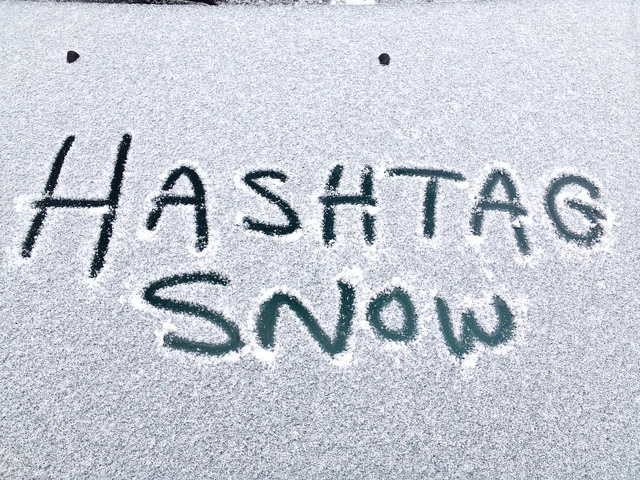
flickr photo shared by AndrewDallos under a Creative Commons ( BY-NC-ND ) license
I’ve been thinking a bit about how hashtags function on Twitter when used in course in particular. These thoughts are shaped mainly by seeing how #vizpoem, #curiouscolab, and #thoughtvectors have played out vs some of the other hashtags we’ve used like #vcualtlab or #vcuglobalhealth.
There’s not a right way or wrong way to do this but there are certain things that seem to happen when the structure of the hashtag is less tied to an institution. The VCU prefix pretty much means that only people within the VCU structure will use that hashtag. It is less likely it’ll become part of a larger structure for other people to use when thinking about/organizing the topic.
#thoughtvectors is an example of a hashtag that has spread beyond the course in both time and people. While I believe Gardner coined?/hashed? the hashtag based on Doug Engelbart’s quote, its first use on Twitter was by Jon Becker (at least according to this site and this site). Since that time it was used extensively during the course (nearly 4000 times) but it’s still being used today long after the course officially ended. More and more it’s used by people who have no obvious relationship to the course and probably no knowledge of its existence. That interests me quite a bit. I see the potential for it to happen with #vizpoem and #curiouscolab.
#ds106 becomes a slightly different kind of scenario to think about (maybe like #phonar). The hashtag has wide adoption and is related to nothing that really matters outside of UMW but it’s focused on the course as an independent entity.1 I wonder if it would have been adopted by people at other institutions if it had been #umwds106. It seems pretty much anything that will make branding/marketing people happy would reduce the likelihood of wider adoption.
The hashtag can be crafted to be inclusive in that way- with part of the consideration being whether it’s something that will encourage (or at least not discourage) external adoption. It can also be used to narrow the group and to focus on the institution. Prepending a university (VCU for instance) or other exclusive designation seems to lower the chance of outside adoption. That keeps your hashtag group tight and other conversations can still occur with outside parties but the hashtag choice has to be considered in that light. Given that often the goal of working in Twitter and on the open is to bring in external participants who don’t have that university affiliation this is a significant choice.
Given the limits of Twitter it may be that making groups (course-related or otherwise) through lists is a better way to create the smaller communities that we’ve often tried to create through these more exclusive hashtags. That’s harder when those groups are fluid and composed of people with widely varying experience with Twitter as a tool. It’s also difficult when the hashtags you want to use have heavy traffic. The idea of a course hashtag become something more than an episodic device (like a conference hashtag often is) and moving towards something used organically that shapes broader conversations is attractive to me.
1 And DS106 is a big thing. It contains multitudes.

Interesting thoughts- the institution prefix likely does limit, but not exclude, and that only works if an outside person knows its an institution. Does “vcu” imply an institution to someone in asia, south america? And if the tweet is interesting, I might be less concerned about what the tag means.
It does make me wonder what the hashtag could do if it did not cost characters in the tweet, e.g. if the hashtag characters did not count against the total. I am mixed on the 140 limit- on one hand it works well to keep a message focused, and I enjoy the cryptic challenge. But there is no real technical limit on the message length, especially as twitter is no longer transmitted by SMS. When you look at the API data associated with each tweet, it is an order of magnitude larger in characters.
I’ve not come across it but would think people have written up some notes on how to find a unique hash tag. It’s often not trivial, and as we know, can be quite fun in the wordplay. Most try to make the tag describe exactly the topic, but what you do well is to pick ones that hint at it more obliquely.
#coolbeans
I think you’re right in that it’s more limiting than exclusionary but I think even (maybe especially) if you don’t know what the prefix means you’ll be less likely to use the hashtag. I don’t think it’s a wrong/right type of thing but I do like the idea of organizing information such that it lives beyond the class.
I would like to see what the auto-translate tries to do with some of those jumbled tags.
Maybe when you’re around we can make a SPLOT that uses the Twitter API and something like the Wordnik API to help generate hashtag possibilities. That’d be fun.
Oops, forgot something. Lists do work well, but hardly anyone knows about them, and I’ve not seen where people use them to group people. have you? They seem like a vestigial twitter organ.
I’ve seen lists used that way a few times. I tended to do it with people who were very new to Twitter.
We use lists with our course for the Dutch Government.